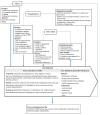Employee-Driven Innovation in Health Organizations: Insights From a Scoping Review
- PMID: 37579391
- PMCID: PMC10425658
- DOI: 10.34172/ijhpm.2023.6734
Employee-Driven Innovation in Health Organizations: Insights From a Scoping Review
Abstract
Background: Employee-driven innovation (EDI) occurs when frontline actors in health organizations use their firsthand experience to spur new ideas to transform care. Despite its increasing prevalence in health organizations, the organizational conditions under which EDI is operationalized have received little scholarly attention.
Methods: This scoping review identifies gaps and assembles existing knowledge on four questions: What is EDI in health organizations and which frontline actors are involved? What are the characteristics of the EDI process? What contextual factors enable or impede EDI? And what benefits does EDI bring to health organizations? We searched seven databases with keywords related to EDI in health organizations. After screening 1580 studies by title and abstract, we undertook full-text review of 453 articles, retaining 60 for analysis. We performed a descriptive and an inductive thematic analysis guided by the four questions.
Results: Findings reveal an heterogeneous literature. Most articles are descriptive (n = 41). Few studies are conceptual and empirical (n = 15) and four are conference papers. EDI was often described as a participatory, learning innovation process involving frontline clinical and non-clinical staff and managers. Majority EDI were top-down, often driven by the organization's focus on participatory improvement and innovation and research-based initiatives. Five categories of methods is used in top-down EDI, two thirds of which includes a learning, a team and/or a digital component. Hybrid EDI often involves a team-based component. Bottom-up EDI emerged spontaneously from the work of frontline actors. Enablers, barriers, and benefits of EDI are seen at macro, organizational, team and individual levels; some benefits spread to other health organizations and health systems.
Conclusion: This scoping review provides a comprehensive understanding of the organizational conditions under which EDI is operationalized. It offers insights for researchers, health organizations, and policy-makers about how and why frontline actors' involvement is crucial for the transformation of care.
Keywords: Bottom-Up Innovation; Frontline Employees; Health System; Innovative Organizations; Scoping Study.
© 2023 The Author(s); Published by Kerman University of Medical Sciences This is an open-access article distributed under the terms of the Creative Commons Attribution License (http://creativecommons.org/licenses/by/4.0), which permits unrestricted use, distribution, and reproduction in any medium, provided the original work is properly cited.
Conflict of interest statement
The authors declare that they have no competing interests nor conflict of interests. Regarding authors’ relationships, SBMC was a postdoctoral research fellow at Health Hub: politics, organizations and law (H-POD), the research center where JLD is the co-director. SBMC and JLD are also affiliated to the Research Center of the Montreal University Hospital Center (CRCHUM). LOD was a doctorate student at the School of Public Health of the University of Montreal where JLD is Professor.
References
-
- Thakur R, Hsu SHY, Fontenot G. Innovation in healthcare: Issues and future trends. J Bus Res. 2012;65(4):562–569. doi: 10.1016/j.jbusres.2011.02.022. - DOI
-
- Hartley J. Eight-and-a-half propositions to stimulate frugal innovation in public services. In: Managing Under Austerity, Delivering Under Pressure: Performance and Productivity in Public Service. Australian National University Press. 2015:238. 10.22459/muadup.10.2015.09. - DOI
-
- Malas K, Jacob R, Dionne KE. L’innovation ouverte et collaborative en santé: l’exemple du CHU Sainte-Justine. Gestion. 2018;43(3):80–55.
-
- Thune T, Mina A. Hospitals as innovators in the health-care system: a literature review and research agenda. Res Policy. 2016;45(8):1545–1557. doi: 10.1016/j.respol.2016.03.010. - DOI
Publication types
MeSH terms
LinkOut - more resources
Full Text Sources


